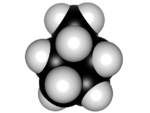Methylcyclopentane
| |||
| Names | |||
|---|---|---|---|
| Preferred IUPAC name
Methylcyclopentane | |||
| Identifiers | |||
3D model (JSmol)
|
|||
| ChEBI | |||
| ChEMBL | |||
| ChemSpider | |||
| ECHA InfoCard | 100.002.277 | ||
| EC Number |
| ||
PubChem CID
|
|||
| UNII | |||
| UN number | 2298 | ||
CompTox Dashboard (EPA)
|
|||
| Properties | |||
| C6H12 | |||
| Molar mass | 84.162 g·mol−1 | ||
| Appearance | Colorless liquid | ||
| Density | 0.749 g/cm3[1] | ||
| Melting point | −142.4 °C (−224.3 °F; 130.8 K)[1] | ||
| Boiling point | 71.8 °C (161.2 °F; 344.9 K)[1] | ||
| Insoluble | |||
| -70.17·10−6 cm3/mol | |||
| Hazards | |||
| Main hazards | flammable | ||
| Flash point | −4 °C (25 °F; 269 K) | ||
| 260 °C (500 °F; 533 K) | |||
Except where otherwise noted, data are given for materials in their standard state (at 25 °C [77 °F], 100 kPa). | |||
| Infobox references | |||
Methylcyclopentane is an organic compound with the chemical formula CH3C5H9. It is a colourless, flammable liquid with a faint odor. It is a component of the naphthene fraction of petroleum. It usually is obtained as a mixture with cyclohexane. It is mainly converted in naphthene reformers to benzene.[2] The C6 core of methylcyclopentane is not perfectly planar and can pucker to alleviate stress in its structure.[3]
References[]
- ^ Jump up to: a b c Lide, David. R, ed. (2009). CRC Handbook of Chemistry and Physics (89th ed.). CRC Press. ISBN 978-1-4200-6679-1.
- ^ M. Larry Campbell (2012). "Cyclohexane". Ullmann's Encyclopedia of Industrial Chemistry. Weinheim: Wiley-VCH. doi:10.1002/14356007.a08_209.pub2.
- ^ Carey, Francis; Giuliano, Robert (2014). "3". Organic Chemistry (9 ed.). McGraw-Hill. pp. 97–131. ISBN 978-0073402741.
Categories:
- Cyclopentyl compounds
- Hydrocarbons


